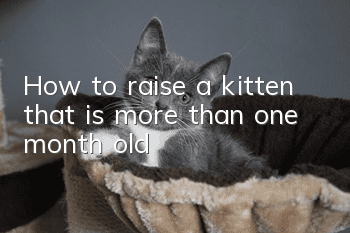How young cats develop

Young cats need the care of their mothers to survive. Many mother cats give birth to babies for the first time and may not take good care of their kittens. At this time, they need the help of their owners, but many owners We don’t understand how young cats develop and grow, so we need to study hard.
The cat is blind and deaf when it is born. It cannot keep warm on its own and needs the help of the female cat to go to the toilet. A cat's nose doesn't fully develop until it's three weeks old, but it can distinguish its mother's scent as soon as it's born. Kittens sleep very long at this time, so if they are meowing, they are usually too cold, feeling unwell, or hungry. The mother cat will use her tongue to stimulate the kitten's anus so that the kitten will excrete.
Kittens weigh about 100 grams at birth and will double in weight in about two weeks. Kittens under two weeks old have a normal heartbeat of more than 200 times per minute and a breathing rate of about 15-35 times per minute. The body temperature of newborn kittens is low, about 35-36°C, and will slowly rise within 1-2 weeks after birth, until it rises to about 37.7°C when they are four weeks old.
Kittens can feel pain when they are just born, but the neuromuscular reflexes related to pain will not be fully developed until they are 7 days old. The eyes will open 5-14 days after birth. At this time, the iris appears gray-blue, which is the so-called gray-blue eyeball. Over the next few weeks, the eyes will slowly change to the color that the adult cat will have, but kittens will not have enough normal vision until they are about 3-4 weeks old. From the age of 7 to 14 days, they will slowly begin to crawl. On the 16th day, they will begin to waddle and learn to walk. By the 21st day, their steps will become more mature and steady.
Cats usually cannot walk steadily until the third week. Before that, they can only rely on the mother cat to move them. Cats will have their first set of teeth when they are two weeks old, and by three weeks they can basically go to the toilet on their own. Cats at this time will also start to play. Cats that are four weeks old will bite and play with each other, and they will also learn how not to hurt each other. In the fifth week, kittens begin to wean, begin to eat solid food, and become independent. At this time, the cat's sense of balance has been fully developed and it also knows how to groom. This period is a learning stage for cats, where they must learn to understand themselves and other animals.
After a cat is two months old, its muscles are fully developed, but it still needs more exercise to accurately judge distance, height and speed. The skills of hunting were also learned during this period. Generally speaking, it is best for kittens to leave their mothers after they are three months old, because when they are three months old, cats have a sense of territory and a good sense of direction.
Even if kittens are from the same litter, the growth and development of each kitten may be different. Some soon live independently; others are very dependent on their mothers. Likewise, the degree of physical development may vary. Usually the last kittens born are the smallest and weakest; the numbers shown below refer to the average kitten.
1. Vision
Open eyes: 8-20 days.
Eye changes to fixed color: 12 weeks
2. Athletic ability
Climbing: 16-20 days
Leaving: 21-25 days
Running: 4-5 weeks
3. Weaning
Start solid food: 3-4 weeks
Complete weaning: 8 weeks
4. Training
Start toilet training: 3-4 weeks
5. Teeth
Eruption of deciduous teeth: 8 weeks
Eruption of permanent teeth: 12-18 weeks
6. Learn skills
Facial washing and hair grooming: 4-5 weeks
Start playing: 4-5 weeks
Start practicing hunting: 6-8 weeks
7. Vaccination and sexual organ removal surgery
First vaccination: Week 9
Second vaccination: Week 12
Female cats have their ovaries removed: after the 32nd week
Castration of male cats: Week 36
8. Live independently from the female cat
Earliest time to leave the female cat: 6-8 weeks
Time to live completely independently from the female cat: 6 months.
Children need our careful care in all aspects, so that the kittens can grow up healthily. While taking care of the kittens, we understand the development history of the kittens, which will allow us to better understand the kittens. It is more convenient during the IPO process.
- Can cats carry rabies virus without getting sick?
- Necessary items for cat bathing
- Advantages and Disadvantages of Bathing Cats
- The cat keeps meowing
- Learn about the symptoms, treatment and management of high blood pressure in cats!
- Can cats be kept free-range? Precautions for free-range cats
- Why do cats like to bite people’s hair?
- How do cats recognize their owners?
- Why do cats like to step on milk? What is the reason and meaning behind it?
- A good way to remove cat tear stains



